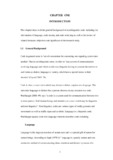Please use this identifier to cite or link to this item:
https://elibrary.tucl.edu.np/handle/123456789/1602| Title: | English Code-Mixing in Saptakoshi Fm: A Case of Request Time |
| Authors: | Khanal, Rishiram |
| Keywords: | English code-mixing;Saptakoshi FM;Itahari;Situational code-switching;Metaphorical code-switching;Conversational code-switching |
| Issue Date: | 2011 |
| Abstract: | This dissertation is primarily a study of English code-mixing in Saptakoshi FM in Itahari. The main objectives of the research study were to find out and analyze English code-mixing in terms of major word classes, frequency of occurrence of the words, contexts in which code-mixing takes place and, find out reasons for English code-mixing. The primary sources of data for this study were 12 radio prorammes of Request Time broadcast from the FM station as well as the 25 radio announcers and 25 radio listeners of the FM radio. The researcher used judgmental or purposive nonrandom sampling procedure for the collection of data. The findings of the research work shows that there is maximum amount of English code-mixing in the programme. It was found out that programme announcers mixed higher amount of English words than the audience. It was also found out that nouns were in the first position, adjectives in the second position, verbs in the third and adverbs were in the last position regarding the number and percentage of the English words mixed. Regarding the context of code-mixing, the announcers and listeners mixed English words in such context as greeting, expressing gratitude, answering telephone call, agreeing, changing the topic of discussion, consoling, requesting, offering, dedicating the songs etc. in the programme. The study extends to four chapters. Chapter one deals with general background, review of related literature, objectives of the study, significant of the study and definitions of specific terms. Chapter two deals with the methodology for study including sources of data, population of the study, tools for data collection and process of data collection. Chapter three includes the analysis and interpretation of data using such simple statistical tools as frequency and percentage. Chapter four consists of findings and recommendations of the research study. |
| URI: | http://elibrary.tucl.edu.np/handle/123456789/1602 |
| Appears in Collections: | English Language Education |
Files in This Item:
| File | Description | Size | Format | |
|---|---|---|---|---|
| Cover 1st.pdf | 34.91 kB | Adobe PDF |  View/Open | |
| Rishi sir Final.pdf | 533.64 kB | Adobe PDF |  View/Open |
Items in DSpace are protected by copyright, with all rights reserved, unless otherwise indicated.
